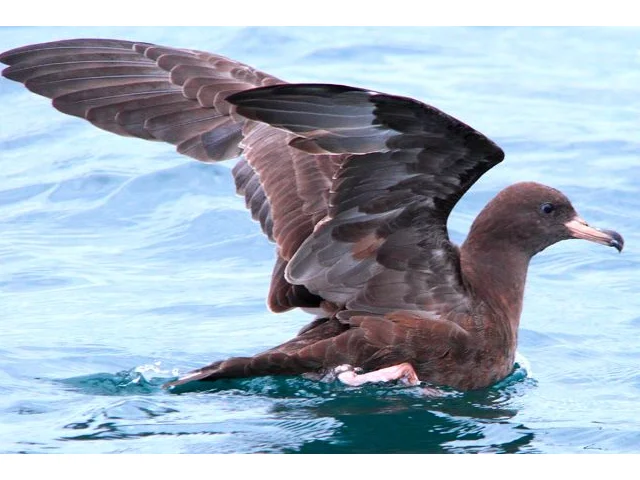Where next for Pacific seabird protection?
c86a6eac-97fd-43e5-9b6b-d96c9469b2c6

BirdLife has said that the breakthroughs in protecting endangered seabirds from long-line fishing still need to reach smaller tuna fishing boats.
BirdLife works through the Western and Central Pacific Fisheries Commission towards seabird protection from long-line fishing by-catch to 25° south, something that has already been achieved in the Indian and Atlantic Oceans. They say there have been many advances towards saving seabirds from long-line fishing mortality in the north Pacific, but there’s also a catch: mitigating measure have yet to reach smaller boats.
Accidental capture of birds by longline fishing vessels is one of the biggest threats to albatross survival worldwide. Karen Baird of Forest and Bird (BirdLife in New Zealand) and the BirdLife International Marine Programme, attended a meeting to strongly advocate for measures to protect seabirds in both the north and south Pacific from accidental by-catch due to long-line fishing.
The jurisdictions of the world’s five tuna Regional Fisheries Management Organisations (RFMOs) overlap with for example 80 per cent of global albatross distribution. As such, the meeting of the Western and Central Pacific Fisheries Commission (itself an RFMO) in Bali, Indonesia, was a vital opportunity to help keep seabirds off hooks.
Large fishing vessels have been required to use two methods of by-catch mitigation to reduce seabird deaths since 2014, however numerous smaller boats have avoided these measures.
“We achieved a breakthrough in the northern hemisphere,” said Karen Baird. “Now small vessels less than 24m long are required to use one seabird by-catch mitigation method, so species that migrate there from New Zealand such as Flesh-footed Shearwater will be better protected, alongside North Pacific albatrosses.”
A new measure for smaller boats will come into effect from January 2017. However, the meeting was a mixed result, said Karen, and “despite this positive progress in the north, [there was] no gain in the southern hemisphere this time round.”
Two proposals were submitted to improve the Conservation and Management Measure for seabirds at this year’s Commission meeting. Both were the result of two years of work by BirdLife International aimed at filling gaps where the available science indicates that mitigation is needed.
“Unfortunately, agreement could not be reached on acceptable measures to protect vulnerable seabirds between 25° and 30° south in the Southern hemisphere,” said Karen. “I think there may be practical issues in particular for some Pacific island countries to adopt mitigation measures at this time, however we hope these can be resolved over the coming year and a measure can be introduced for adoption at the next Commission meeting.
“BirdLife is very pleased to finally have protection for seabirds required on all vessels in the north Pacific, but long term we would like to see two measures required on small vessels and it’s not over yet.”
BirdLife say that there is clearly more work to do for all participating countries to reach agreement and ensure seabirds are protected from accidental by-catch.
BirdLife works through the Western and Central Pacific Fisheries Commission towards seabird protection from long-line fishing by-catch to 25° south, something that has already been achieved in the Indian and Atlantic Oceans. They say there have been many advances towards saving seabirds from long-line fishing mortality in the north Pacific, but there’s also a catch: mitigating measure have yet to reach smaller boats.
Accidental capture of birds by longline fishing vessels is one of the biggest threats to albatross survival worldwide. Karen Baird of Forest and Bird (BirdLife in New Zealand) and the BirdLife International Marine Programme, attended a meeting to strongly advocate for measures to protect seabirds in both the north and south Pacific from accidental by-catch due to long-line fishing.
The jurisdictions of the world’s five tuna Regional Fisheries Management Organisations (RFMOs) overlap with for example 80 per cent of global albatross distribution. As such, the meeting of the Western and Central Pacific Fisheries Commission (itself an RFMO) in Bali, Indonesia, was a vital opportunity to help keep seabirds off hooks.
Large fishing vessels have been required to use two methods of by-catch mitigation to reduce seabird deaths since 2014, however numerous smaller boats have avoided these measures.
“We achieved a breakthrough in the northern hemisphere,” said Karen Baird. “Now small vessels less than 24m long are required to use one seabird by-catch mitigation method, so species that migrate there from New Zealand such as Flesh-footed Shearwater will be better protected, alongside North Pacific albatrosses.”
A new measure for smaller boats will come into effect from January 2017. However, the meeting was a mixed result, said Karen, and “despite this positive progress in the north, [there was] no gain in the southern hemisphere this time round.”
Two proposals were submitted to improve the Conservation and Management Measure for seabirds at this year’s Commission meeting. Both were the result of two years of work by BirdLife International aimed at filling gaps where the available science indicates that mitigation is needed.
“Unfortunately, agreement could not be reached on acceptable measures to protect vulnerable seabirds between 25° and 30° south in the Southern hemisphere,” said Karen. “I think there may be practical issues in particular for some Pacific island countries to adopt mitigation measures at this time, however we hope these can be resolved over the coming year and a measure can be introduced for adoption at the next Commission meeting.
“BirdLife is very pleased to finally have protection for seabirds required on all vessels in the north Pacific, but long term we would like to see two measures required on small vessels and it’s not over yet.”
BirdLife say that there is clearly more work to do for all participating countries to reach agreement and ensure seabirds are protected from accidental by-catch.

